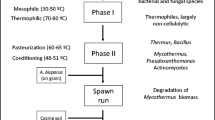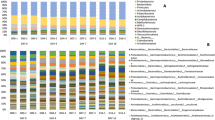Abstract
Agaricus bisporus is the most widely cultivated mushroom species in the world. Cultivation is commenced by inoculating beds of semi-pasteurised composted organic substrate with a pure spawn of A. bisporus. The A. bisporus mycelium subsequently colonises the composted substrate by degrading the organic material to release nutrients. A layer of peat, often called “casing soil”, is laid upon the surface of the composted substrate to induce the development of the mushroom crop and maintain compost environmental conditions. Extensive research has been conducted investigating the biochemistry and genetics of A. bisporus throughout the cultivation process; however, little is currently known about the wider microbial ecology that co-inhabits the composted substrate and casing layers. The compost and casing microbial communities are known to play important roles in the mushroom production process. Microbial species present in the compost and casing are known for (1) being an important source of nitrogen for the A. bisporus mycelium, (2) releasing sugar residues through the degradation of the wheat straw in the composted substrate, (3) playing a critical role in inducing development of the A. bisporus fruiting bodies and (4) acting as pathogens by parasitising the mushroom mycelium/crop. Despite a long history of research into the mushroom cropping process, an extensive review of the microbial communities present in the compost and casing has not as of yet been undertaken. The aim of this review is to provide a comprehensive summary of the literature investigating the compost and casing microbial communities throughout cultivation of the A. bisporus mushroom crop.

Similar content being viewed by others
References
Ahlawat OP, Vijay B (2010) Potential of thermophilic bacteria as microbial inoculant for commercial scale white button mushroom (Agaricus bisporus) compost production. J Sci Ind Res 69:948–955
Berendsen RL, Baars JJP, Kalkhove SIC, Lugones LG, Wosten HAB, Bakker PAHM (2010) Lecanicillium fungicola: causal agent of dry bubble disease in white-button mushroom. Mol Plant Pathol 11(5):585–595. https://doi.org/10.1111/j.1364-3703.2010.00627.x
Berendsen RL, Kalkhove SIC, Lugones LG, Wosten HAB, Bakker PAHM (2012) Germination of Lecanicillium fungicola in the mycosphere of Agaricus bisporus. Environ Microbiol Rep 4(2):227–233. https://doi.org/10.1111/j.1758-2229.2011.00325.x
Bonnen AM, Anton LH, Orth AB (1994) Lignin-degrading enzymes of the commercial button mushroom, Agaricus bisporus. Appl Environ Microbiol 60(3):960–965
Brown M, Chang MCY (2014) Exploring bacterial lignin degradation. Curr Opin Chem Biol 19:1–7. https://doi.org/10.1016/j.cbpa.2013.11.015
Cai WM, Yao HY, Feng WL, Jin QL, Liu YY, Li NY, Zheng Z (2009) Microbial community structure of casing soil during mushroom growth. Pedosphere 19(4):446–452. https://doi.org/10.1016/S1002-0160(09)60137-5
Carrasco J, Navarro MJ, Gea FJ (2017) Cobweb, a serious pathology in mushroom crops: a review. Span J Agric Res 15(2):e10R01. https://doi.org/10.5424/sjar/2017152-10143
Choudhary DK (2011) First preliminary report on isolation and characterization of novel Acinetobacter spp. in casing soil used for cultivation of button mushroom, Agaricus bisporus (Lange) Imbach. Int J Microbiol 2011:1–6. https://doi.org/10.1155/2011/790285
Derikx PJL, de Jong GAH, Op den Camp HJM, Van der Drift C, Van Griensven LJLD, Vogels GD (1989) Isolation and charactelization of thermophilic methanogenic bacteria from mushroom compost. FEMS Microbiol Ecol 62(4):251–258. https://doi.org/10.1111/j.1574-6968.1989.tb03699.x
Derikx PJL, Op den Camp HJM, Van der Drift C, Van Griensven LJLD, Vogels GD (1990) Biomass and biological activity during the production of compost used as a substrate in mushroom cultivation. Appl Environ Microbiol 56(10):3029–3034
Eastwood D, Green J, Grogan H, Burton K (2015) Viral agents causing brown cap mushroom disease of Agaricus bisporus. Appl Microbiol Ecol 81(20):7125–7134
Fermor TR, Wood DA (1981) Degradation of bacteria by Agaricus bisporus and other fungi. J Gen Microbiol 126:377–387
Fermor TR, Wood DA, Lincoln SP, Fenlon JS (1991) Bacteriolysis by Agaricus bisporus. J Gen Microbiol 137(1):15–22. https://doi.org/10.1099/00221287-137-1-15
Fu Y, Wang X, Li D, Liu Y, Song B, Zhang C, Wang Q, Chen M, Zhang Z, Li Y (2016) Identification of resistance to wet bubble disease and genetic diversity in wild and cultivated strains of Agaricus bisporus. Int J Mol Sci 17(10):1568. https://doi.org/10.3390/ijms17101568
Hackett R (2015) Spent mushroom compost as a nitrogen source for spring barley. Nutr Cycl Agroecosys 102(2):253–263. https://doi.org/10.1007/s10705-015-9696-3
Jolivet S, Arpin N, Wichers HJ, Pellon G (1998) Agaricus bisporus browning: a review. Mycol Res 102(12):1459–1483. https://doi.org/10.1017/S0953756298006248
Jurak E, Patyshakuliyeva A, de Vries RP, Gruppen H, Kabel MA (2015) Compost grown Agaricus bisporus lacks the ability to degrade and consume highly substituted xylan fragments. PLoS One 10(8):e0134169. https://doi.org/10.1371/journal.pone.0134169
Kabel MA, Jurak E, Makela MR, de Vries RP (2017) Occurrence and function of enzymes for lignocellulose degradation in commercial Agaricus bisporus cultivation. Appl Microbiol Biotechnol 101(11):4363–4369. https://doi.org/10.1007/s00253-017-8294-5
Largeteau ML, Savoie JM (2010) Microbially induced diseases of Agaricus bisporus: biochemical mechanisms and impact on commercial mushroom production. Appl Microbiol Biotechnol 86(1):63–73. https://doi.org/10.1007/s00253-010-2445-2
McGee CF, Byrne H, Irvine A, Wilson J (2017a) Diversity and dynamics of the DNA and cDNA-derived compost fungal communities throughout the commercial cultivation process for Agaricus bisporus. Mycologia 109(3):475–484. https://doi.org/10.1080/00275514.2017.1349498
McGee CF, Byrne H, Irvine A, Wilson J (2017b) Diversity and dynamics of the DNA and cDNA-derived bacterial compost communities throughout the Agaricus bisporus mushroom cropping process. Ann Microbiol 67(11):751–761. https://doi.org/10.1007/s13213-017-1303-1
Mouthier TMB, Kilic B, Vervoort P, Gruppen H, Kabel MA (2017) Potential of a gypsum-free composting process of wheat straw for mushroom production. PLoS One 12(10):e0185901. https://doi.org/10.1371/journal.pone.0185901
Nagy LG, Tóth R, Kiss E, Slot J, Gácser A, Kovács GM (2017) Six key traits of fungi: their evolutionary origins and genetic bases. Microbiol Spectr 5(4): FUNK-0036-2016
Noble R, Fermor TR, Lincoln S, Dobrovin-Pennington A, Evered C, Mead A, Li R (2003) Primordia initiation of mushroom (Agaricus bisporus) strains on axenic casing materials. Mycologia 95(4):620–629. https://doi.org/10.1080/15572536.2004.11833066
Noble R, Dobrovin-Pennington A, Hobbs PJ, Pederby J, Rodger A (2009) Volatile C8 compounds and pseudomonads influence primordium formation of Agaricus bisporus. Mycologia 101(5):583–591. https://doi.org/10.3852/07-194
Patyshakuliyeva A, Jurak E, Kohler A, Baker A, Battaglia E, de Bruijn W, Burton KS, Challen MP, Coutinho PM, Eastwood DC, Gruben BS, Mäkelä MR, Martin F, Nadal M, van den Brink J, Wiebenga A, Zhou M, Henrissat B, Kabel M, Gruppen H, de Vries RP (2013) Carbohydrate utilization and metabolism is highly differentiated in Agaricus bisporus. BMC Genomics 14(1):663
Patyshakuliyeva A, Post H, Zhou M, Jurak E, Heck AJ, Hildén KS, Kabel MA, Mäkelä MR, Altelaar MA, de Vries RP (2015) Uncovering the abilities of Agaricus bisporus to degrade plant biomass throughout its life cycle. Environ Microbiol 17(8):3098–3109. https://doi.org/10.1111/1462-2920.12967
Pecchia J, Cortese R, Albert I (2014) Investigation into the microbial community changes that occur in the casing layer during cropping of the white button mushroom, Agaricus bisporus. In: Singh M (ed) Proceedings of the 8th International Conference on Mushroom Biology and Mushroom Products, New Delhi, pp 309–313
Riahi H, Eskash A, Shariatmadari Z (2011) Effect of bacterial and cyanobacterial culture on growth, quality and yield of Agaricus bisporus. Mushroom biology and mushroom products. In: Savoie JM, Foulongne-Oriol M, Largeteau M, Barroso G (eds) Proceedings of the 7th International Conference on Mushroom Biology and Mushroom Products, Arcachon, France, Vol 1, pp 406–411
Royse DJ, Sanchez JE, Beelman RB, Davidson J (2008) Re-supplementing and re-casing mushroom (Agaricus bisporus) compost for a second crop. World J Microbiol Biotechnol 24(3):319–325. https://doi.org/10.1007/s11274-007-9473-9
Samuels GJ, Dodd SL, Gams W, Castlebury LA, Petrini O (2002) Trichoderma species associated with the green mold epidemic of commercially grown Agaricus bisporus. Mycologia 94(1):146–170. https://doi.org/10.1080/15572536.2003.11833257
Savoie JM (1998) Changes in enzyme activities during early growth of the edible mushroom, Agaricus bisporus, in compost. Mycol Res 102(9):113–118
Savoie JM, Foulongne-Oriol M, Barroso G, Callac P (2013) Genetics and genomics of cultivated mushrooms, application to breeding of agarics. In: Kempken F (ed) Agricultural applications. The Mycota (a comprehensive treatise on fungi as experimental systems for basic and applied research), vol 11. Springer, Berlin, pp 3–33
Sharma HSS, Kilpatrick M (2000) Mushroom (Agaricus bisporus) compost quality factors for predicting potential yield of fruiting bodies. Can J Microbiol 46(6):515–519. https://doi.org/10.1139/w00-012
Sharma HSS, Kilpatrick M, Lyons G (2005) Monitoring mushroom compost quality during production and cropping. In: Tan Q, Zhang J, Chen M, Cao H, Buswell JA (eds) Fifth International Conference on Mushroom Biology and Mushroom Products, Shanghai Academy of Agricultural Sciences, Shanghai, China, pp 221–235
Sharma A, Singh AV, Johri BN (2013) Functional and genetic characterization of culturable bacteria associated with late phase of mushroom composting assessed by amplified rDNA restriction analysis. Int J Microbiol App Sci 2(6):162–175
Siyoum NA, Surridge K, van der Linde EJ, Korsten L (2016) Microbial succession in white button mushroom production systems from compost and casing to a marketable packed product. Ann Microbiol 66(1):151–164. https://doi.org/10.1007/s13213-015-1091-4
Sonnenberg ASM, Baars JJP, Hendrick PM, Lavrijssen B, Gao W, Weijn A, Mes, JJ (2011) Breeding and strain protection in the button mushroom Agaricus bisporus. In: Savoie JM, Foulongne-Oriol M, Largeteau M, Barroso G (eds) Proceedings of the 7th International Conference on Mushroom Biology and Mushroom Products, Genomics, Genetics and Breeding, Arcachon, France, Vol 7(9), pp 7–15
Stewart DPC, Cameroon KC, Cornforth IS (1998) Effects of spent mushroom substrate on soil chemical conditions and plant growth in an intensive horticultural system: a comparison with inorganic fertiliser. Aust J Soil Res 36(2):185–198. https://doi.org/10.1071/S97076
Straatsma G, Samson RA, Olijnsma TW, Camp HJMOD, Gerrits JPG, van Griensven LJLD (1994) Ecology of thermophilic fungi in mushroom compost, with emphasis on Scytalidium thermophilum and growth stimulation of Agaricus bisporus mycelium. Appl Environ Microbiol 60(2):454–458
Szekely AJ, Sipos R, Berta B, Vajna B, Hajdu C, Marialigeti K (2009) DGGE and T-RFLP analysis of bacterial succession during mushroom compost production and sequence-aided T-RFLP profile of mature compost. Microb Ecol 57(3):522–533. https://doi.org/10.1007/s00248-008-9424-5
Van Griensven LJLD, Van Roestel AJJ (2004) The cultivation of the button mushroom Agaricus bisporus in The Netherlands: a successful industry. Rev Mex Micol 19:95–102
Vos AM, Heijboer A, Boschker HTS, Bonnet B, Lugones LG, Wösten HAB (2017a) Microbial biomass in compost during colonization of Agaricus bisporus. AMB Express 7(1):12. https://doi.org/10.1186/s13568-016-0304-y
Vos AM, Jurak E, Pelkmans JF, Herman K, Pels G, Baars JJ, Hendrix E, Kabel MA, Lugones LG, Wösten HAB (2017b) H2O2 as a candidate bottleneck for MnP activity during cultivation of Agaricus bisporus in compost. AMB Express 7(1):124. https://doi.org/10.1186/s13568-017-0424-z
Zhang X, Zhong Y, Yang S, Zhang W, Xu M, Ma A, Zhuang G, Chen G, Liu W (2014) Diversity and dynamics of the microbial community on decomposing wheat straw during mushroom compost production. Bioresour Technol 170:183–195. https://doi.org/10.1016/j.biortech.2014.07.093
Acknowledgements
The author would like to thank Dr. Silvia Saloni and Dr. Noel Faherty for kindly taking the time to review the draft manuscripts during the preparation of this publication.
Author information
Authors and Affiliations
Corresponding author
Ethics declarations
Conflict of interest
The author declares that he has no conflict of interest.
Compliance with ethics requirements
This article does not contain any studies with human or animal subjects.
Rights and permissions
About this article
Cite this article
McGee, C.F. Microbial ecology of the Agaricus bisporus mushroom cropping process. Appl Microbiol Biotechnol 102, 1075–1083 (2018). https://doi.org/10.1007/s00253-017-8683-9
Received:
Revised:
Accepted:
Published:
Issue Date:
DOI: https://doi.org/10.1007/s00253-017-8683-9




